Did you know that over half of mobile users abandon sites that take over 3 seconds to load? Now, let’s try a quick experiment and count to three.
One.
Two.
Three.
Did these seconds feel long for you? When you think about the experiment, maybe they didn’t feel that long; but when users are not consciously aware of their behaviors while browsing the web, three seconds have been proven to be way too long. This is especially true in today’s scroll-culture — with the popularity of 15-second TikToks and 280-character Tweets, today’s consumer (Gen Z especially) is accustomed to absorbing information through quick intakes. In 2022, the average consumer attention span dropped to just 8 seconds, meaning that it’s becoming more and more difficult to capture and maintain user attention.
The conclusion? Immediately engaging marketing copywriting is the backbone of success. To get your prospect to act, you need to grab their attention, hold it, keep it engaged, and guide them to their intended action. From website landing pages, to emails, and push notifications, almost every marketing initiative includes some sort of copy, meaning that copywriting is a crucial skill that every marketer needs to have.
Let’s start with the basics.
What is copywriting for marketing content?
Copywriting is writing any sort of language to be used in advertising. We also use the term “copy” to describe text on websites, social media, marketing emails, etc. While marketing copywriting in itself is a profession, it’s also a critical skill that all great growth marketers should have in their toolbox. The ability to write copy that captivates and engages the intended viewer with the right messaging isn’t easy, but if you’re interested in getting better at it, you’ve come to the right place.
What does a marketing copywriter do?
Marketing copywriters act as the voice and the storyteller of a certain brand, product, or service. They mold and control their target audiences’ perceptions, using words to achieve certain marketing objectives, such as increasing awareness, driving conversions, or fostering loyalty. Copywriters usually work closely with creative departments to present a holistic brand story through a cohesive, strategic combination of words and visual elements.
As an interdisciplinary space, marketing copywriters often come from a variety of different backgrounds, straddling the midpoint between creative writing, marketing strategy, consumer psychology, and communication sciences. On one hand, it’s important for marketing copywriters to have a strong background in writing and have the ability to confidently manipulate words to achieve different tones of voice, writing styles, and sentence structures.
On the other hand, having an extensive writing background does not necessarily equate to being a good copywriter; skilled copywriters should also have some experience in marketing strategy and understand the importance of customizing copy to different target audiences, funnel stages, and platforms.
If you are looking to become a marketing copywriter, or if you’re a copywriter looking to further improve your skills, you’ve come to the right place.
Why is copywriting important?
The easiest way to envision the importance of copywriting is to see it as the intersection of growth, creativity, and community. Whether it be through driving action or increasing awareness, good copywriting leverages the strategic approach of targeted communication and the creative power of emotive writing to build relationships between brands and consumers.
The benefits of successful copywriting are manifold, but the keys ones are:
- Growth: good copywriting efficiently drives users through the conversion funnel, thus increasing revenue, ROI and profits
- Creativity: good copywriting elicits specific consumer emotions and supplements brand visuals to tell a holistic story, thus solidifying brand awareness and recall
- Community: good copywriting will resonate with target audiences and build long-term customer relationships that stimulate growth loops, decrease CAC and increase customer LTV.
Copywriting is the backbone of almost all of a brand’s touchpoints. From landing pages to emails, social ads to SEM — nailing down the right copy for the right audience, channel, and funnel stage is the first step towards sustainable and measurable impact.
What is the difference between copywriting and storytelling?
These days, everyone has a story or content to spread. Whether it’s a food blog or the latest brand launch, people are constantly surrounded by new pieces of content. But what makes your content matter? Stand out? Cut through all the copy clutter that we are exposed to every day?
The foundation of good marketing copywriting is storytelling, but the two are not mutually dependent. The word “storytelling” actually speaks for itself. It is about telling stories, and being able to engage your audience, or to make something more clear. Photos, pictures, graphs, and videos really elevate the storytelling as well. Storytelling is all about painting the picture, setting the scene, and taking the reader on a journey.
Copywriting is one of the most critical elements of all forms of marketing and advertising and is also tied to great storytelling. It is like a call-to-action on a bigger scale, trying to catch your audience’s attention and make them feel, think, or respond. The product, called “copy” or “marketing copy”, is the written content aiming to increase brand awareness and ultimately to persuade the audience to perform a particular action.
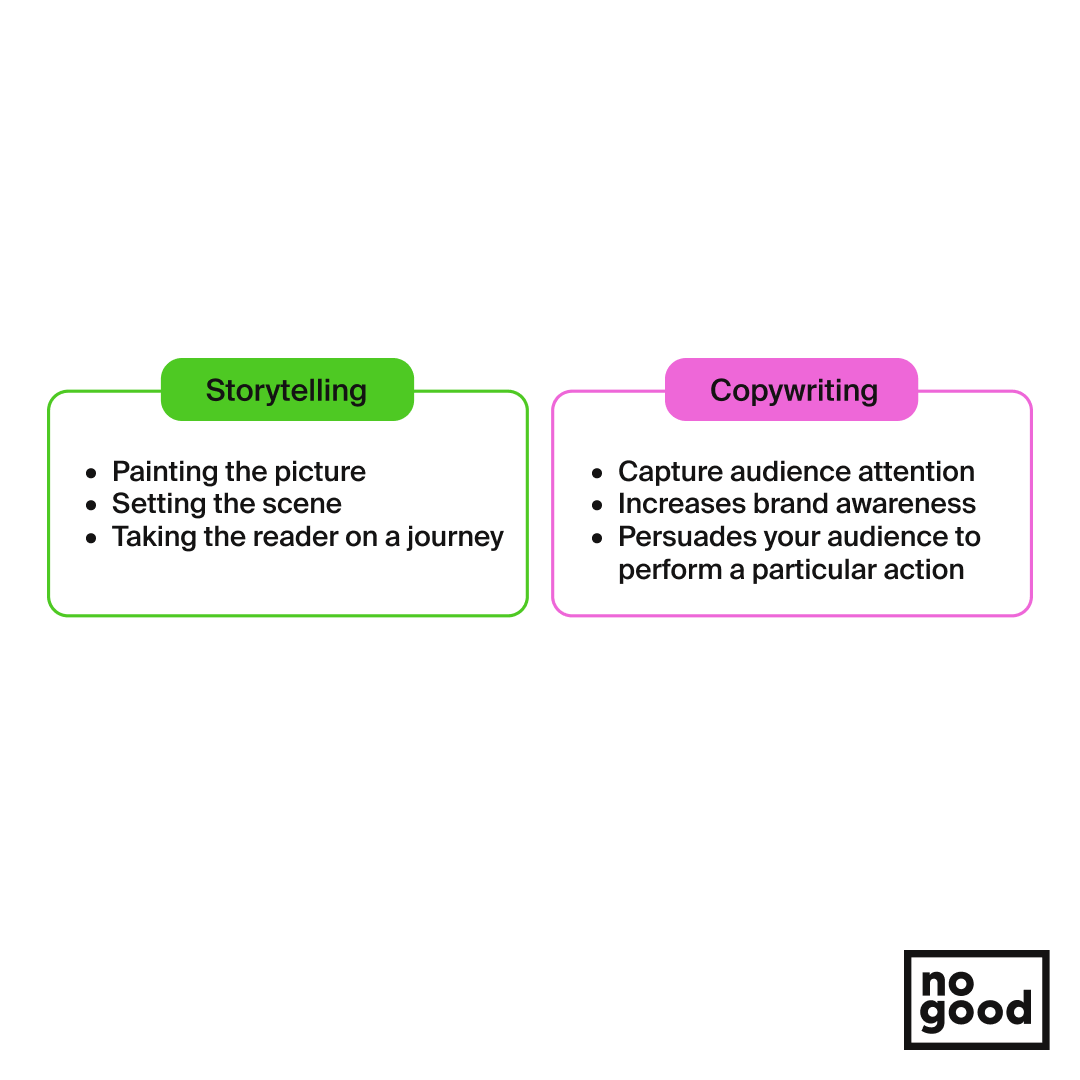
A successful brand understands that the customer needs to be the hero of the story, meaning that the storytelling aspect of copywriting must align with your customer’s own story. This means putting your customer’s needs first and thinking about the “what’s in it for me” aspect of the consumer perspective. Consumers want to interact with brands that share their values and principles, and it’s the brand’s job to make that alignment clear to them.
Essentially, the goal here is to put the audience at the center of your brand story — make it clear as to what’s in it for them, and how the product or service you offer relates to their day-to-day. In Donald Miller’s book, “Building a Story Brand”, he introduces the SB7 framework, which outlines critical rules that a brand should follow when writing marketing copy.
Here is the SB7 framework:
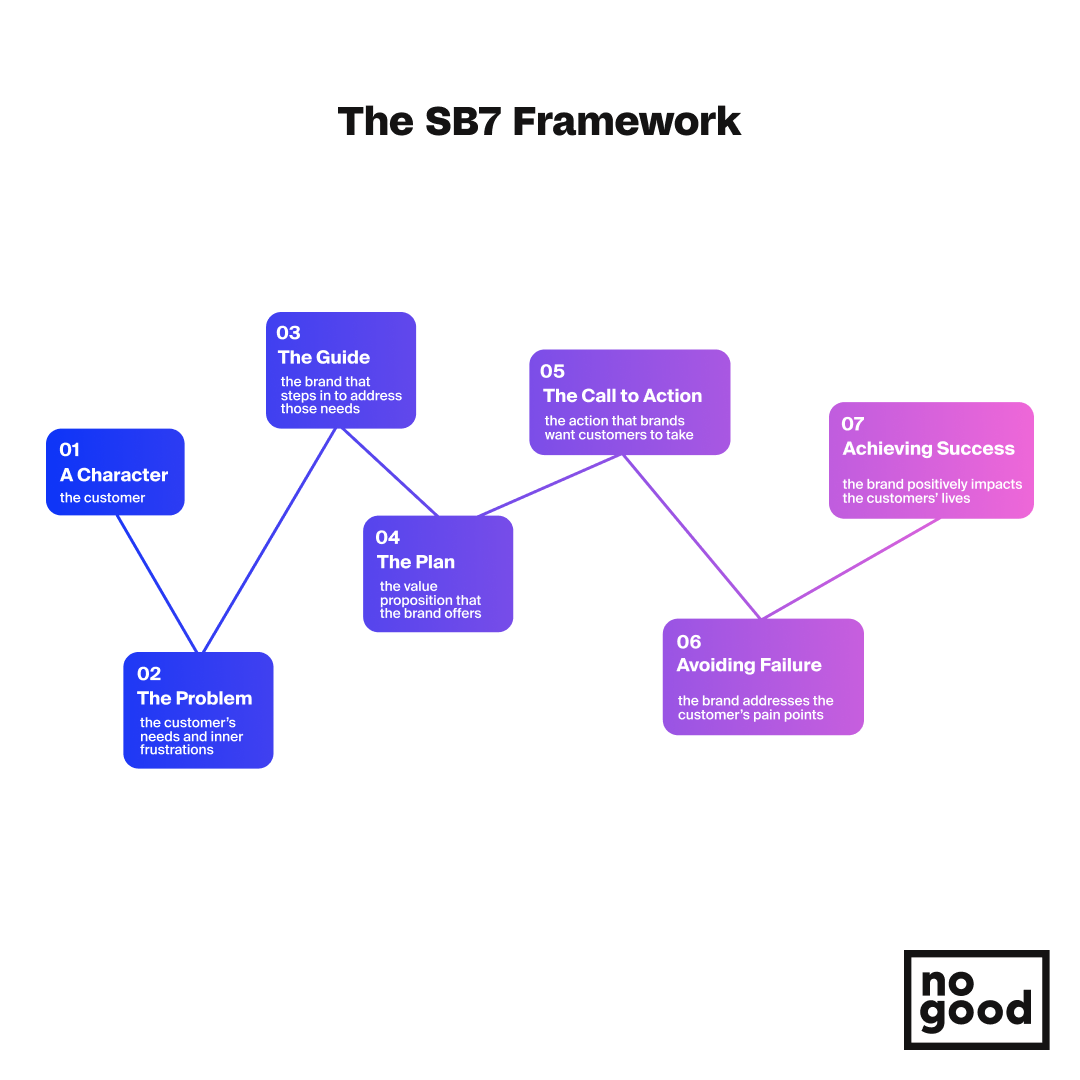
Let’s use Apple as an example. Their copywriting strategy mirrors the SB7 framework and positions their ideal customer as the “hero” of their journey.
1. The Character
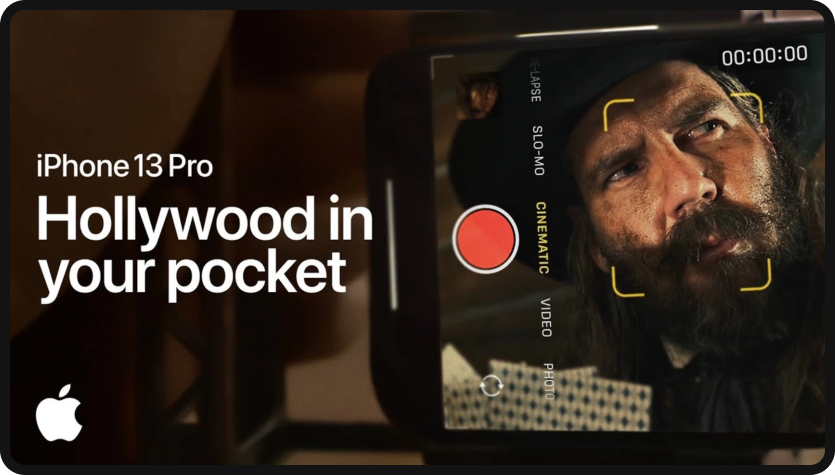
Apple identified their target customer as aspiring filmmakers who care about having a good camera, then framed that character as the hero of the story.
2. The Problem
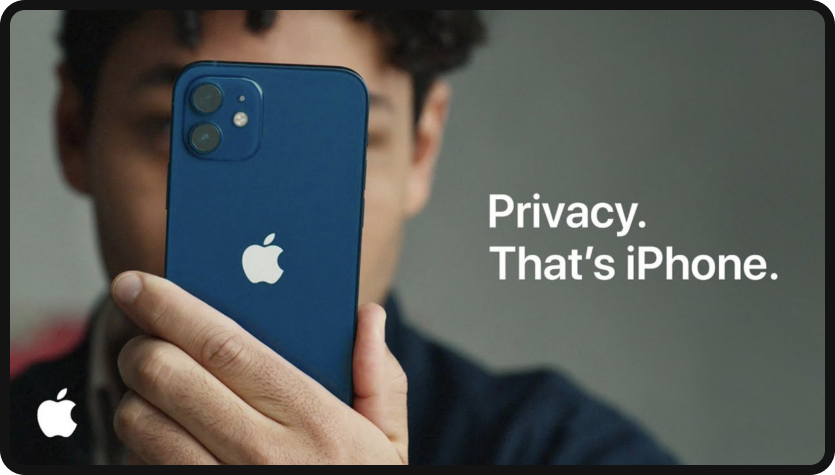
Apple identified privacy as the key problem for their hero.
3. The Guide
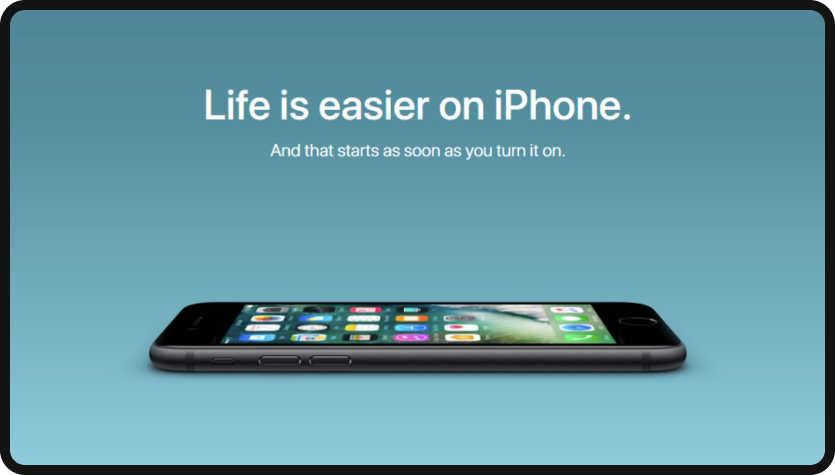
Apple positioned itself as the guide that can help make their customers’ (heroes’) lives easier.
4. The Plan
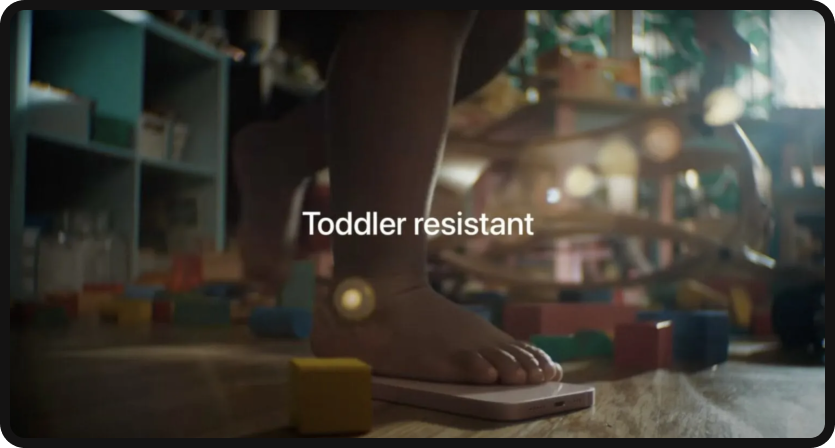
Apple highlights their value proposition — which in this case is product durability — as a plan to help their hero solve their problem.
5. The Call to Action
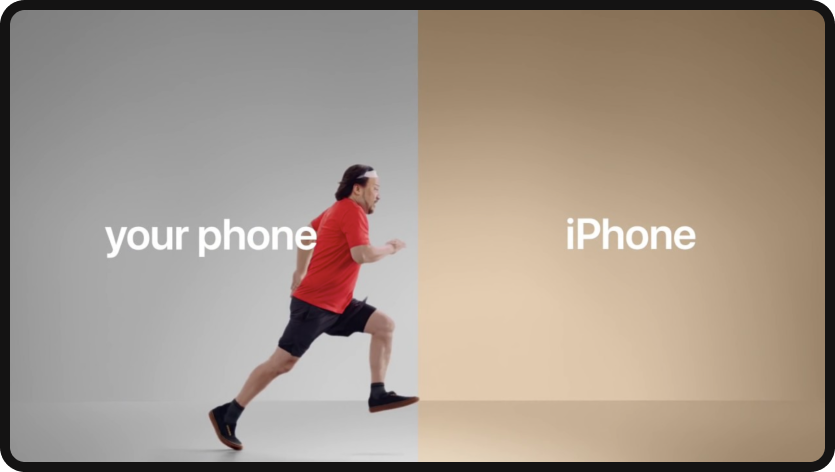
Apple urges Android users to take action and make the switch to iPhone.
6. Avoiding Failure
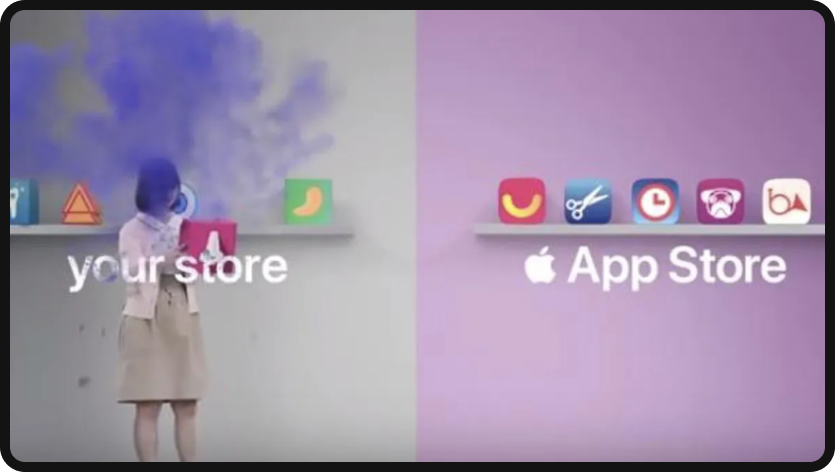
Apple illustrates how the hero can make their life easier by switching to iPhone.
7. Achieving Success
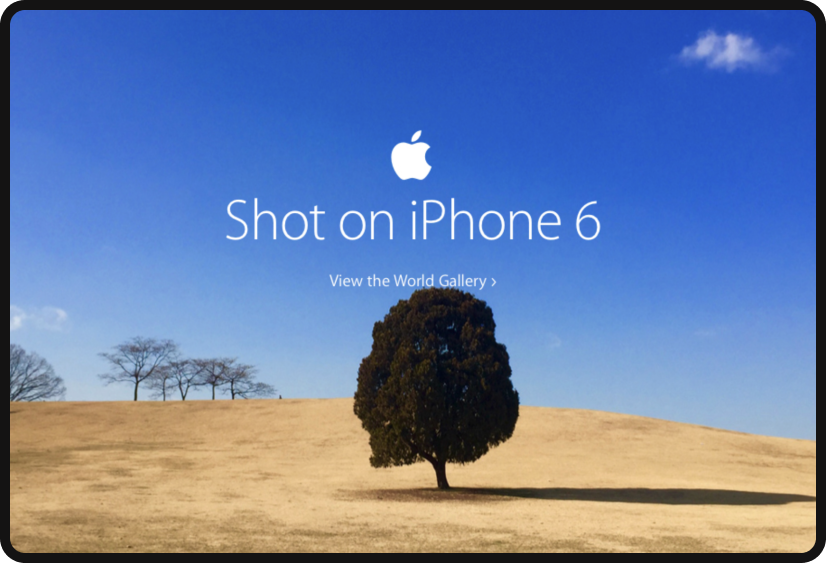
Instead of listing specs and features, Apple uses an image to show what success looks: a high-quality image shot on iPhone.
Ultimately, marketing copywriting is improved by the ability to tell a good story, but that story must be told with the customer as the hero — not the brand. This ensures that the storytelling aspect drives consumers toward the end goal of taking action.
What are some copywriting frameworks?
The AIDA Framework
The AIDA framework stands for Attention, Interest, Desire, and Action.
The steps to executing this framework are as follows:
- Attention: Get your reader’s attention with something catchy and relevant (question, statement, urgency, etc.).
- Interest: Facts, social proof, and numbers capture the reader’s attention every time.
- Desire: Make them desire the product/service provided
- Action: Add a call to action to tell the reader what to do next
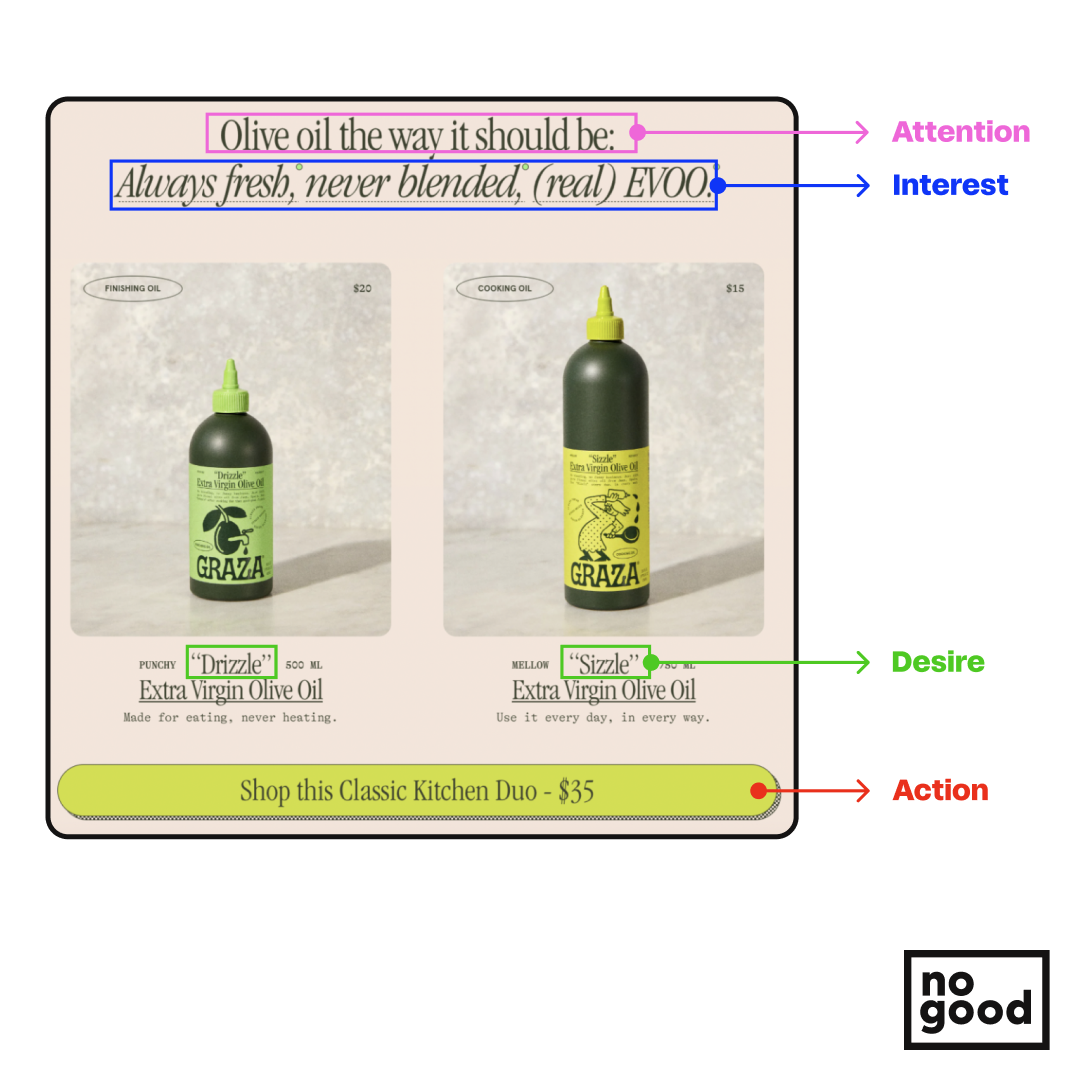
For example, the olive oil brand Graza uses the AIDA framework on its landing page to convert initial attention to action:
- Attention: “Olive oil the way it should be” engages audiences that are interested in high-quality cooking oils
- Interest: “Always fresh, never blended, (real) EVOO” lists out the product benefits, uses, and facts to validate the value proposition
- Desire: Descriptive words such as “Drizzle” and “Sizzle” stimulates further interest in the product
- Action: A clear call to action of “Shop this classic kitchen duo” drives the user to conversion
Harking back to the principle of storytelling through copywriting, the AIDA framework takes the consumer through a journey from start to finish, using each new step to build on previously established attention or trust.
The Problem-Solution Framework
Determine the value props that will matter to these people, and provide them with the solution for their needs. A useful exercise to write better copy is to list out 5-10 problems your target market deals with, the effects of these problems, and then how your product or service solves them.
Let’s look at a simple example. If we were a DTC eCommerce company that sold hiking boots, these are a few of the problems and solutions we would list:
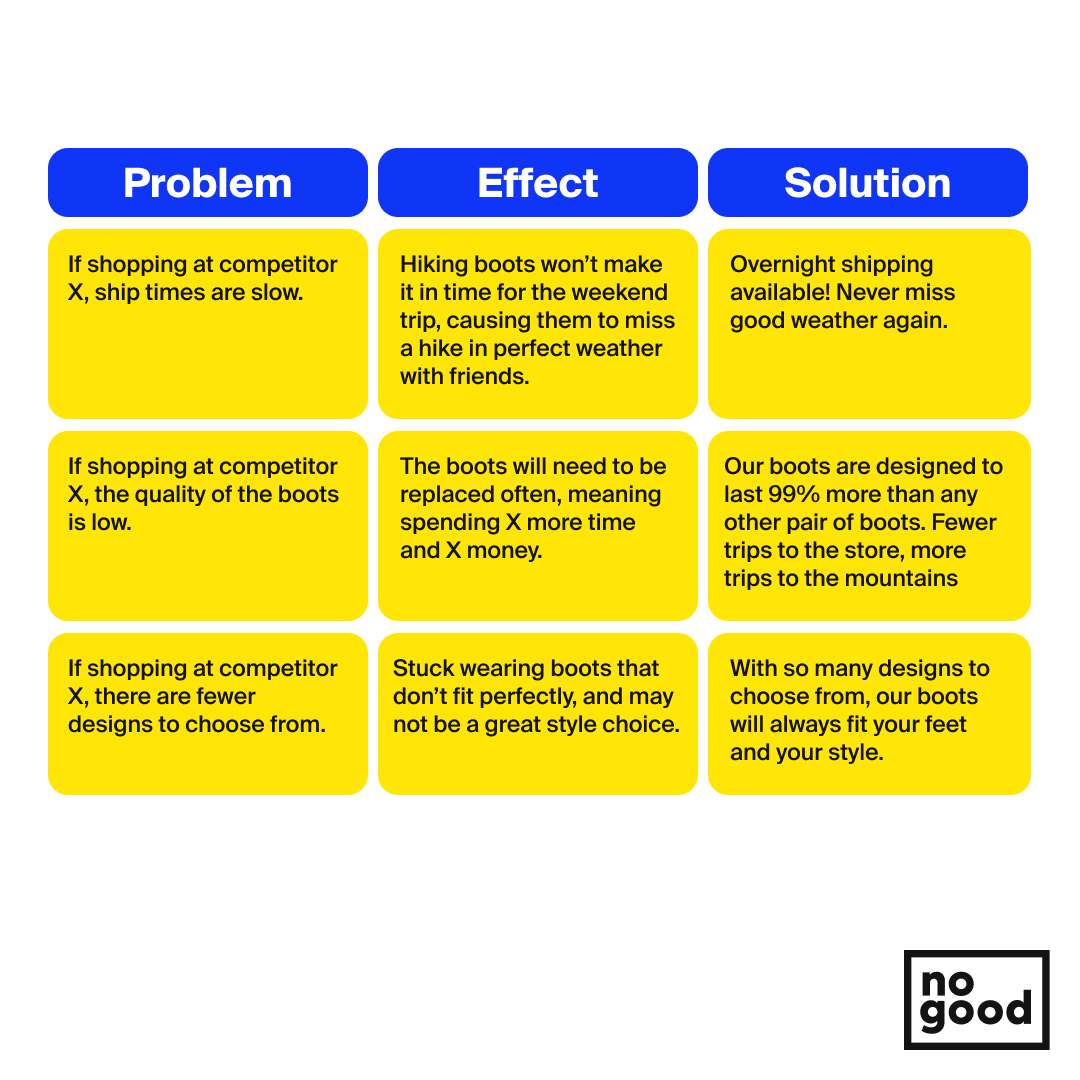
Just like that, in our solutions column, we suddenly have three lines of copy that will resonate with our target market. The more rows you are able to complete, the more options you will have ready to launch when the time comes.
The 4 U’s Headline Framework
Start with the 4U’s that produce good content: Useful, Urgent, Unique, and Ultra-Specific. Keep the copy short, cut the fluff, and think of how to package your message in the shortest yet most powerful way.
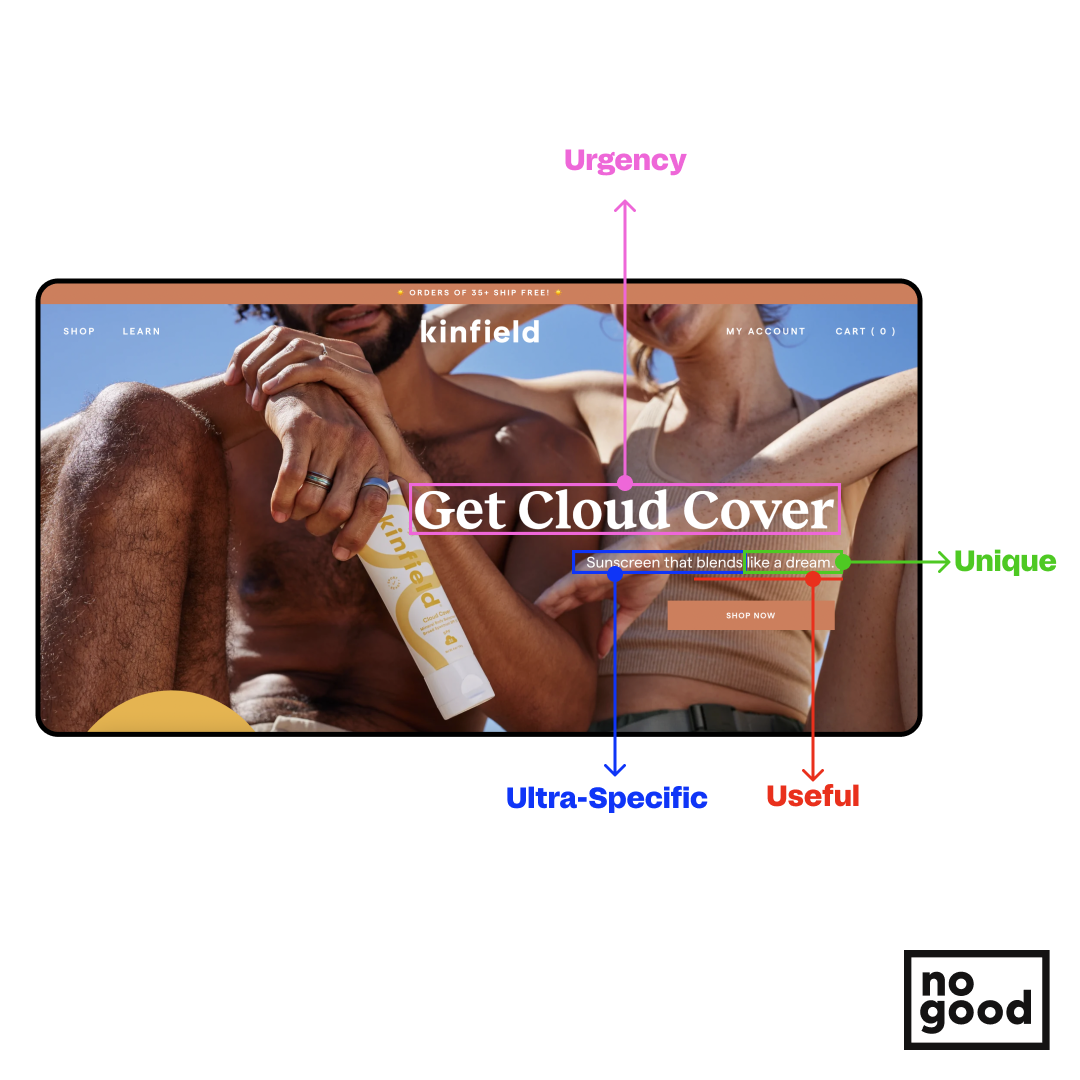
The 4 C’s Framework
Make sure that your copy adheres to the 4 C’s: Concise, Clear, Credible, and Compelling.
Concise: Writing with clarity means being concise. Unnecessary words often dilute the meaning of the conveyed message.
Clear: Don’t use fancy words just for the sake of it. Good, clear copy cuts like a knife. Avoid big words that make you sound like you are trying too hard.
Credible: Research your topic so that you appear as a person with a genuine interest in offering your help and expertise and, of course, know your audience inside and out.
Compelling: Don’t be afraid to inject creativity and a unique voice into your copy so that you can keep your audience engaged amongst the noise.
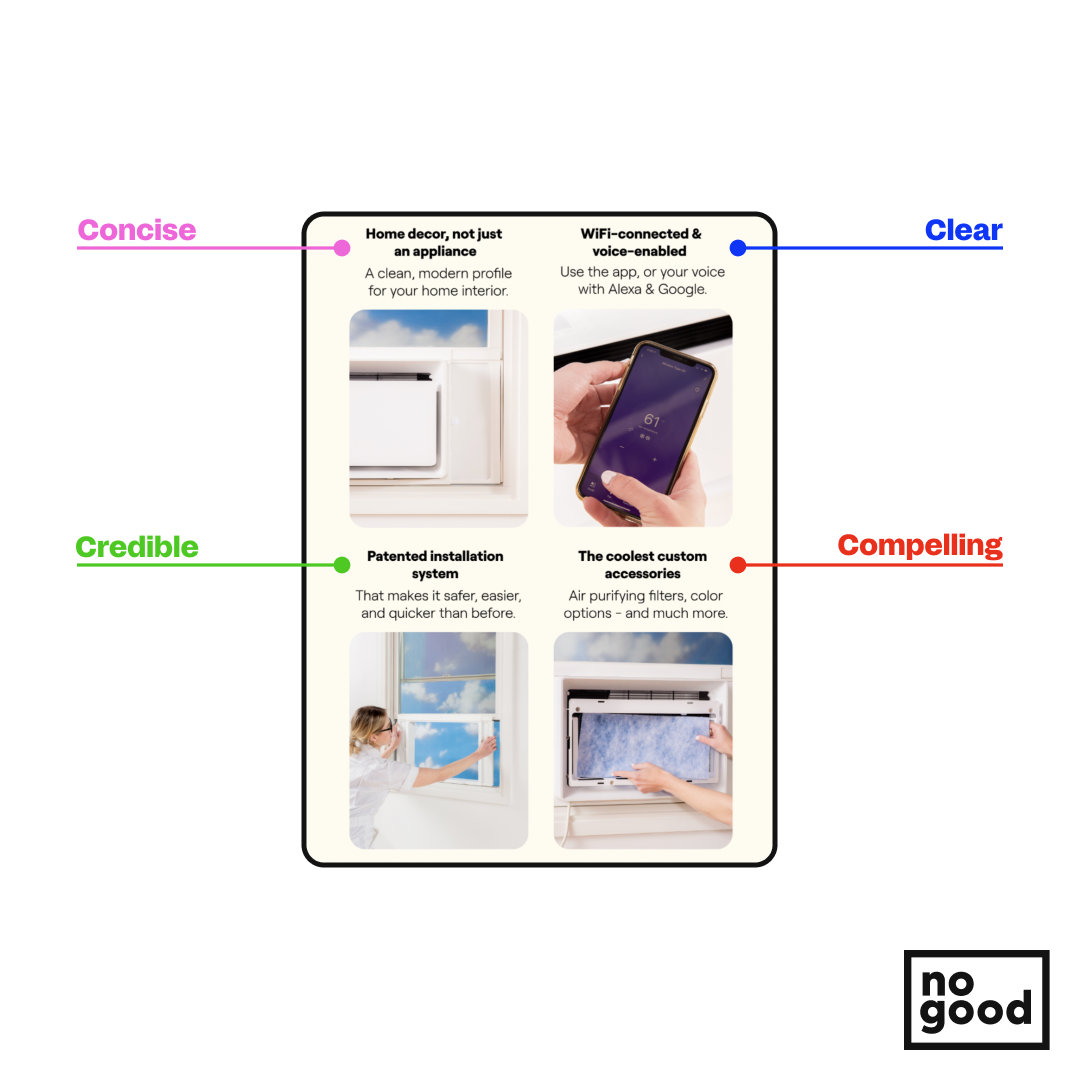
The Before-After-Bridge (B.A.B) Framework
The Before-After-Bridge framework positions your brand’s product or service as the missing piece to bring you from problem to solution. For example, coffee brand Taika communicates the benefits of its drinks by illustrating the:
- Before: “coffee has been focused on where it was grown and not how it makes you feel”
- After: “the world’s first perfectly calibrated coffee”
- Bridge: “That’s why we made Taika”
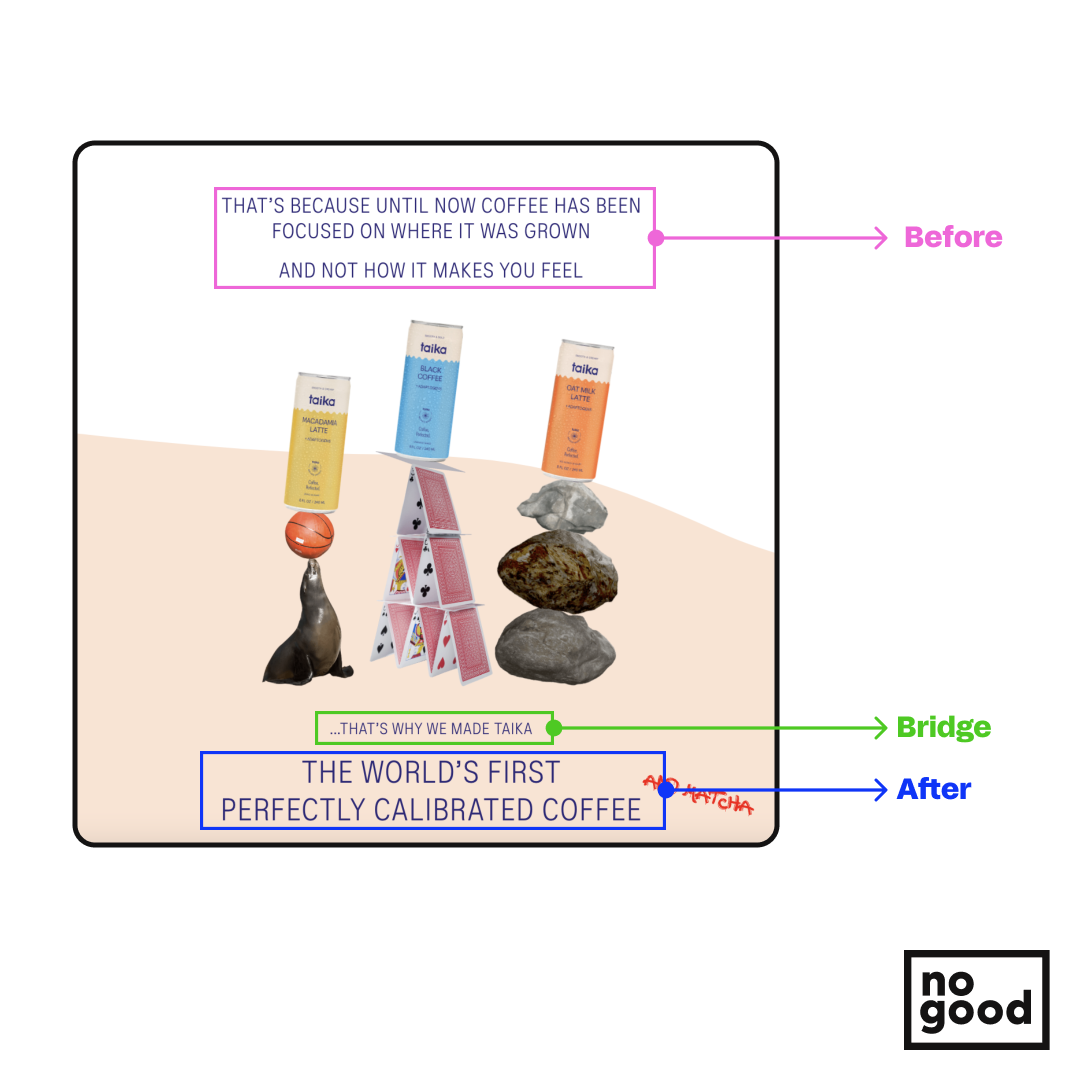
The Feature-Advantage-Benefit Framework
The Feature-Advantage-Benefit framework is a straightforward and easy way to communicate what your brand does and why your consumers should care. This 3-step formula includes stating:
- Feature: what the product/service feature is
- Advantage: what advantage it has
- Benefit: what the consumer gains from using the feature
Refresh, a plant-based gum brand, uses this framework in their “Garden Mint” product description.
- Feature: “Mint gum like never before”
- Advantage: “Fresh taste of mint straight from the garden…”
- Benefit: “Freshen up your breath…”
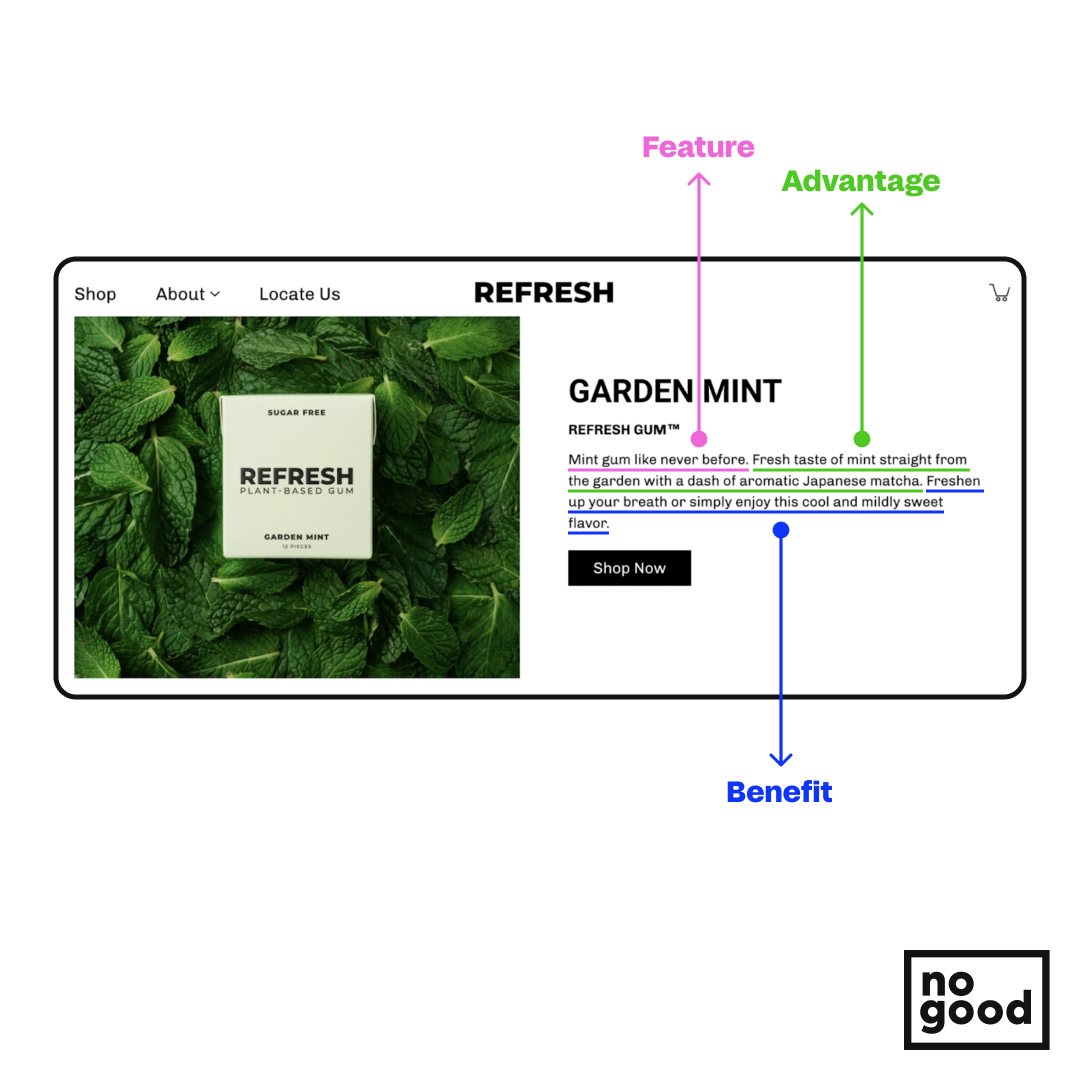
The Contrast x Complement Framework
Two is better than one. Use contrasting and complementary words to create a paired mirroring effect that is both engaging and concise. Here are some examples.
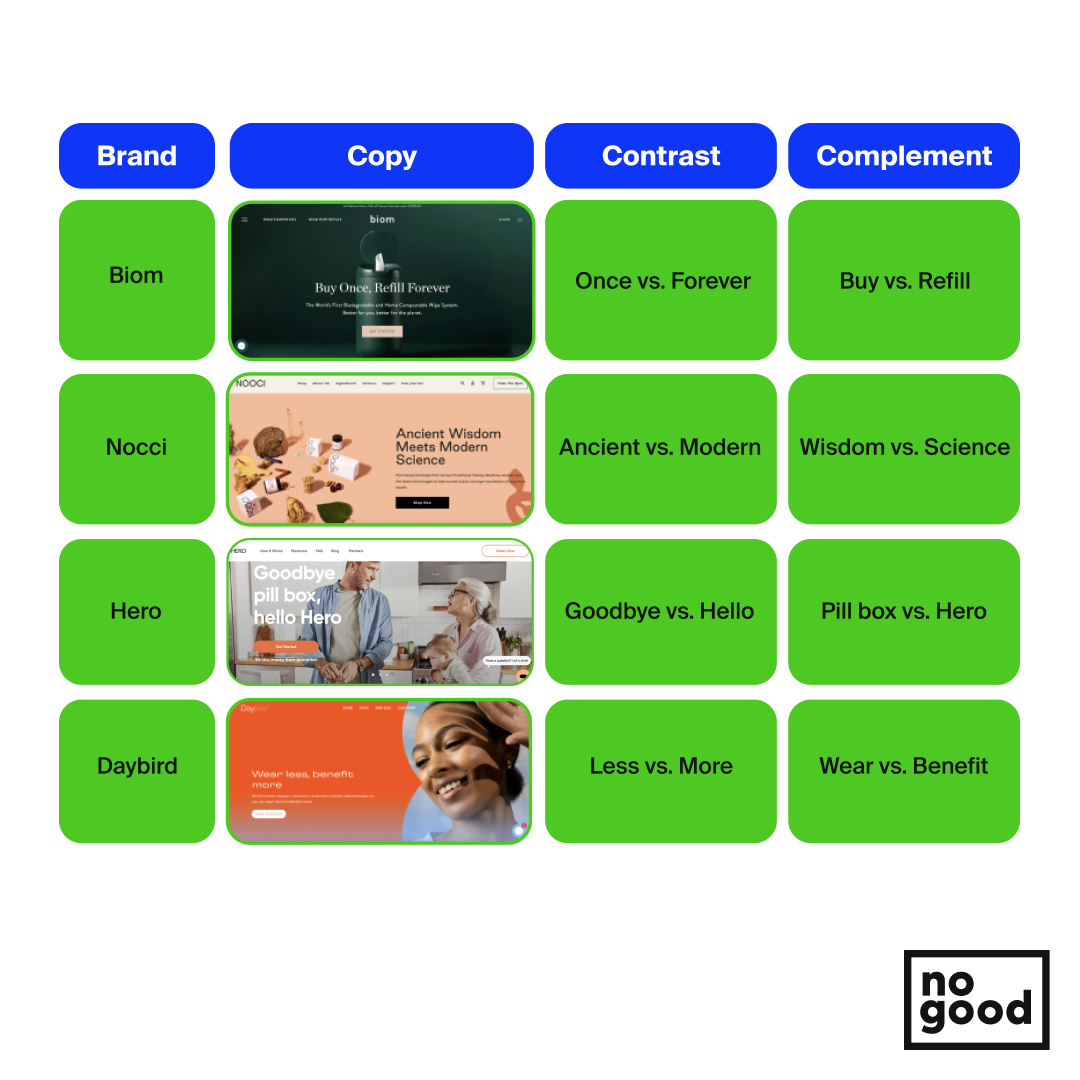
What is good marketing copywriting?
Good marketing copywriting extends beyond the basic principles of good writing; although it is certainly important to achieve quality through writing style, flow, grammar, and sentence structure, good marketing copywriting is so much more than just that.
The difference between “good” and “bad” copywriting lies in the question of whether or not the piece of copy is able to achieve the established marketing goals — whether it be impressions, revenue, or conversions.
This challenge of goal-oriented marketing copywriting involves a couple of important considerations:
- Target audience: how can you frame your tone of voice to resonate with your target audience and create a relationship with the consumer you are communicating with?
- Funnel stage: where is your audience in terms of their buyer’s journey and what information is most important to surface to them at this stage of their process?
- Platform: what platform are your writing copy for, and how can you make sure that the copy fits within the appropriate conventions and requirements of the platform?
Writing with these marketing considerations in mind will ensure that your copywriting is working towards achieving a specific, measurable and strategic goal.
How do you write copy for different funnel stages?
Identifying what part of the funnel the user is in is crucial to relevant marketing copywriting that drives conversions. After all, the audience that sees your copy will have a different level of familiarity with your brand — so it’s important to meet them where they are, with the right answers they need. Here is a rough framework (with examples!) that will help you think of the user journey more holistically and write copy that is more relevant to your intended audience.
Top of Funnel Copywriting
At the top of the funnel, you want to focus on brand awareness and give the viewer as much valuable information about your brand as possible. Who are you? What do you do? Why do you do it and why should the viewer care? Content that answers these questions will get the quality recall you need lower down the funnel.
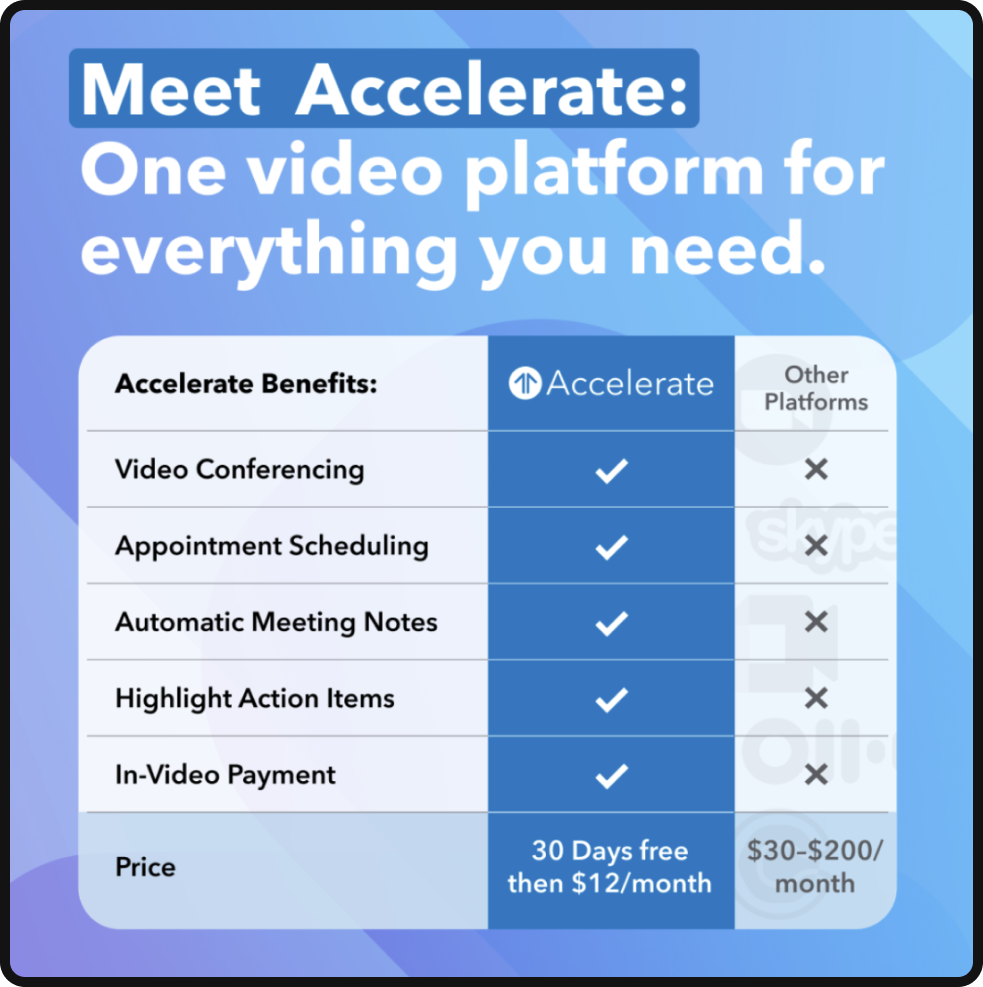
For example, this ad for Accelerate, a video conferencing platform, demonstrates what the product is and why viewers should care about it. The copy focuses on providing valuable information such as product benefits, price, and competitive advantage, so as to attract consumers’ attention and increase brand awareness. It also uses the 4 U’s Headline Framework with copy that is Useful (“everything you need”), Urgent (“Meet Accelerate”), Unique (“one video platform for everything”), and Ultra-Specific (“video platform”).
Middle of Funnel Copywriting
At the middle of the funnel, you have users who have a rough recall of your brand. You want to get more specific here: what are the exact products/services that you offer? What is the unique value proposition of each? What are some statistics or testimonials you can use to drive conversions? Be as specific as possible to build on the recall and drive their decision.
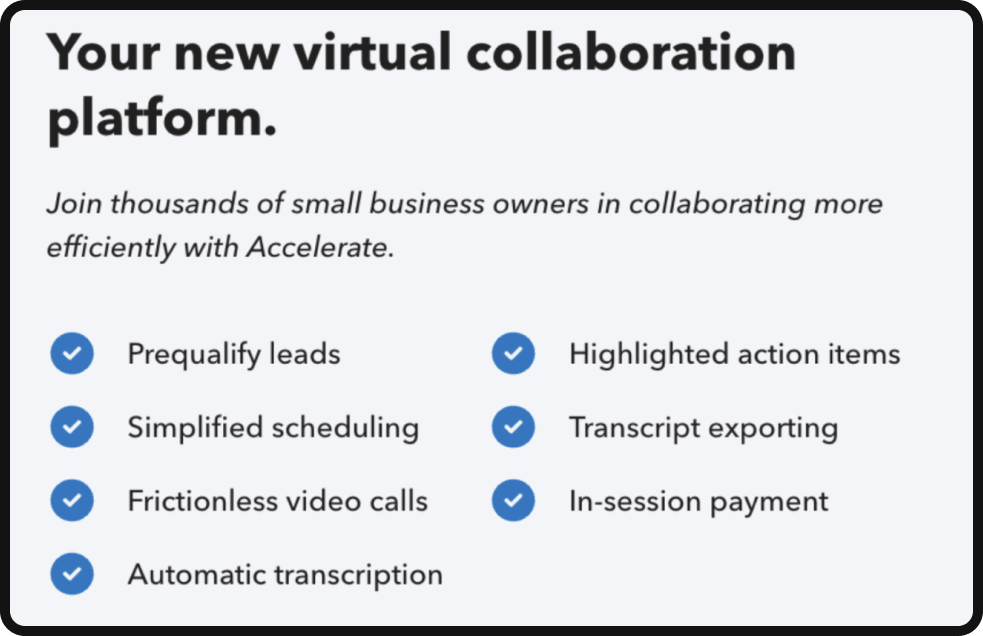
Continuing with the Accelerate example, the copywriting style on the platform’s Sign In page demonstrates the specificity required for middle-of-funnel copywriting. The copy identifies what the product is (“a virtual collaboration platform”), and uses a bullet checklist to highlight exactly what features the product offers (“simplified scheduling”, “frictionless video calls” etc). This level of clarity builds upon the customer’s existing recall of the brand, and uses additional information to drive their decision forward. The copy also uses the 4 C’s framework with a concise headline, a clear list of benefits, a credible user base (“thousands of small business owners”), and a compelling value proposition.
Bottom of Funnel Copywriting
At the bottom of the funnel, you have users who already know your brand and your offerings — and they need an extra push to finally convert. At this stage, you can be very straightforward with a harder sell (that still falls within your brand voice and remains consistent with your overall messaging). Tell the user what specific actions they should take in order to find the value they are looking for. Introducing extra urgency, discounts, limited-time offers, and perks at this stage can help seal the deal.
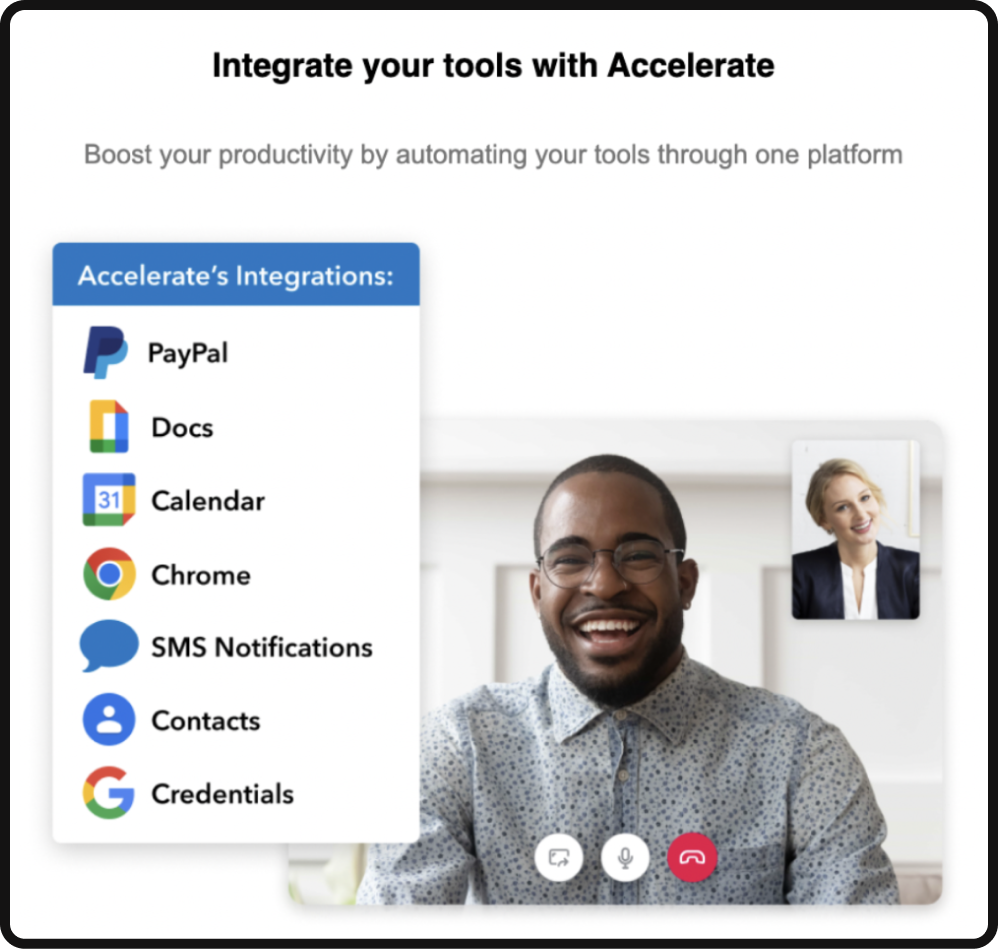
This email on Accelerate’s suite of integrations is sent to all registered users. These are users that are already familiar with the brand and have likely interacted with the product itself. By drawing attention to Accelerate’s suite of integrations, this email prompts users to take action (“integrate your tools with Accelerate”), and increases customer retention by incentivizing the user to revisit the platform. This email also uses the Feature-Benefit-Advantage framework by emphasizing how the Integration feature has the benefit of automated tools for the advantage of boosted productivity.
How do you write copy for different platforms?
Different channels are designed to reach different audiences, at different peak times, and within different character limits. Each channel is built for a specific audience, hence there needs to be a different style of writing. Your visuals vary by channel, so why shouldn’t your copywriting do the same? The key to channel specific copywriting is to understand the intention of the user where you are meeting them.
When you think about it as a user, it seems obvious, but this is often lost on time-strapped marketers attempting to push content out rapidly. While it may be time-effective to copy and paste, when the copy doesn’t convert on engagement, you’re going to wish you had spent more time considering where your copy was going to live and how it would be consumed.
Landing Page Copy
The key to writing good landing page copy is to capture the user’s attention immediately and guide them through the brand story as they (ideally) scroll through the site. In an eye tracking study conducted by Nielson, results showed that 57% of users’ page-viewing time is spent above the fold (ATF), and 74% of the viewing time was spent in the first two screenfulls (up to 2160px). What this means is that the hero section or ATF needs to convey the value of the brand immediately in order to capture users’ attention before they lose interest.
Within the hero section and consistently throughout the entire landing page, there should be clear CTA buttons that ask users to take action. Common examples of these landing page CTAs can include “Shop Now”, “Learn More”, or “Get Started”.
Take Windmill, a modern air conditioner brand, for example. Their hero section displays a compelling headline, “eye candy for your window”, and uses an illustrative metaphor to convey the aesthetic benefit of their product. The “Shop Now” CTA is also immediately obvious.

Another important copy element to include on the landing page is social proof. Use numbers or customer testimonials to build trust — after you’ve fully explained what the product or service is and what value you can provide. Windmill does this on its landing page by including testimonials from users and reviews from well-known publications.

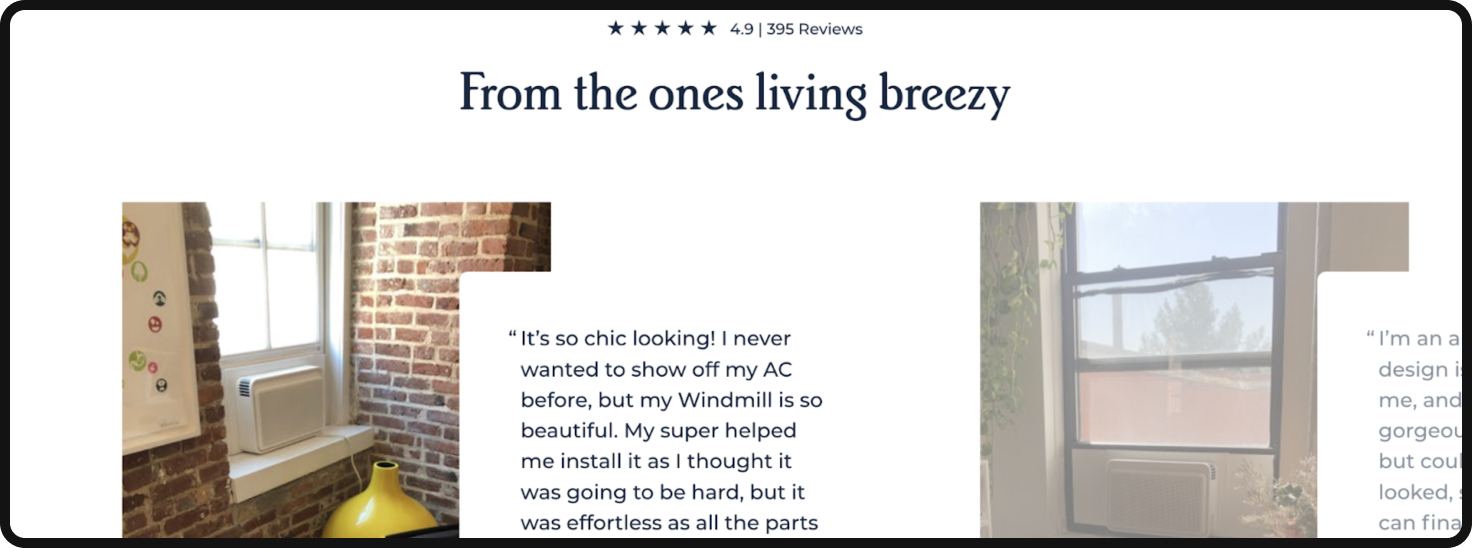
Ultimately, the landing page should follow a linear information hierarchy, with the main value at the top, followed by supporting benefits and information as the user scrolls.
Social Ad Copy
When writing copy for ads, it’s crucial to combine both text and visuals to allow the two elements to support one another in telling a story. Ad copy should also balance emotional and rational appeal prior to outlining a clear call to action.
In order to write a compelling ad copy, you must be concise while demonstrating a clear understanding of the problem and how the brand solves it. Understanding your customer’s pain points is the first step to convincing your customers how your brand can help solve their problems.
Meditation brand Headspace, for example, combines emotional language like “a happier, healthier life” with more rational statistics like “28% less sad”. The ad immediately communicates how Headspace can help solve the consumer’s problem (which in this case is sadness) by providing a solution (i.e. a guide to health and happiness). A CTA of “Install Now” is clearly outlined, and the main message of the entire ad can be perceived in less than 8 seconds.
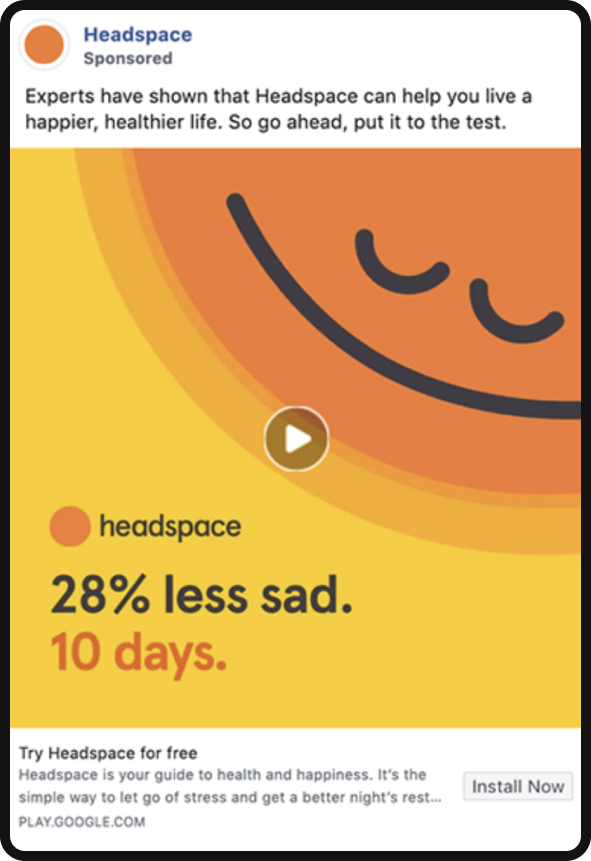
Search Ad Copy
Writing copy for SEM (search engine marketing) requires an ability to speak to the user’s search intent while also communicating key value propositions within limited character counts. Google search ads allow headlines of up to 30 characters and descriptions of up to 90 characters. Copywriting for search engine marketing should be straightforward, concise, and clearly communicate the value of the product or service in response to the user’s search intent.
Figma’s search ad copy responds to the search intent of finding “the best graphic design tool” by emphasizing its effortless interface and its speed capabilities. In one short headline, Figma’s search ad is able to communicate its promise to the user to “make designing effortless” and help them “create designs faster”.
It’s important to note that for newer brands, SEM is often used to test various value propositions in order to better understand which key features users are most interested in. In the case of search ad testing, copywriters should aim to create different headline and description variations that each clearly highlight a different value proposition, so as to facilitate better experimentation and data-backed insights.
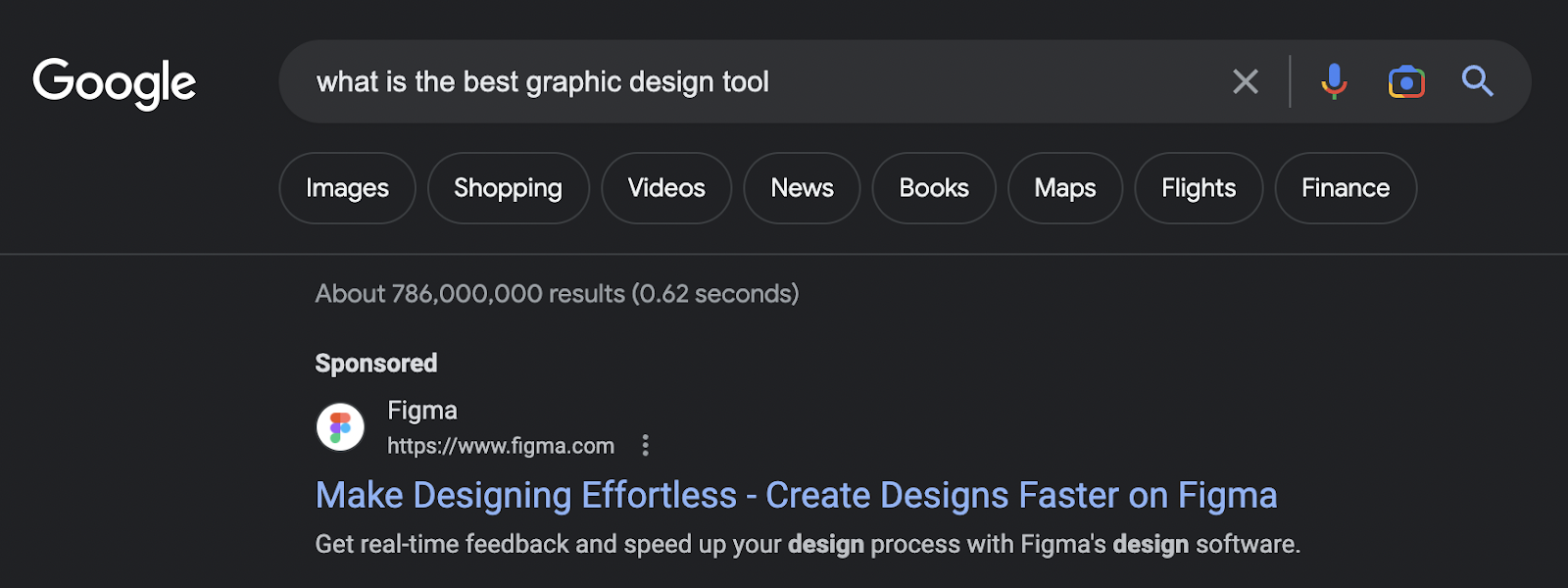
Email Copy
Email copy is similar to ad copy except with more real estate. Like the landing page, the key message and CTA needs to be above the fold to immediately capture the user’s attention. Like ads, the headline and key message need to be short, clear, and demonstrate how your brand can help your consumers solve a problem. Although the relatively longer length of an email offers more room to get creative, it doesn’t mean that you should write a lengthy and monotonous piece — it should still be clear, concise, and get straight to the point.
Magic Spoon taps into its value proposition right from the first line, “Best in class breakfast”. Then, the email follows with a clear “Try Now” CTA that is supplemented with clear product benefits such as “Cheaper than a protein bar” and “No grains or gluten”.
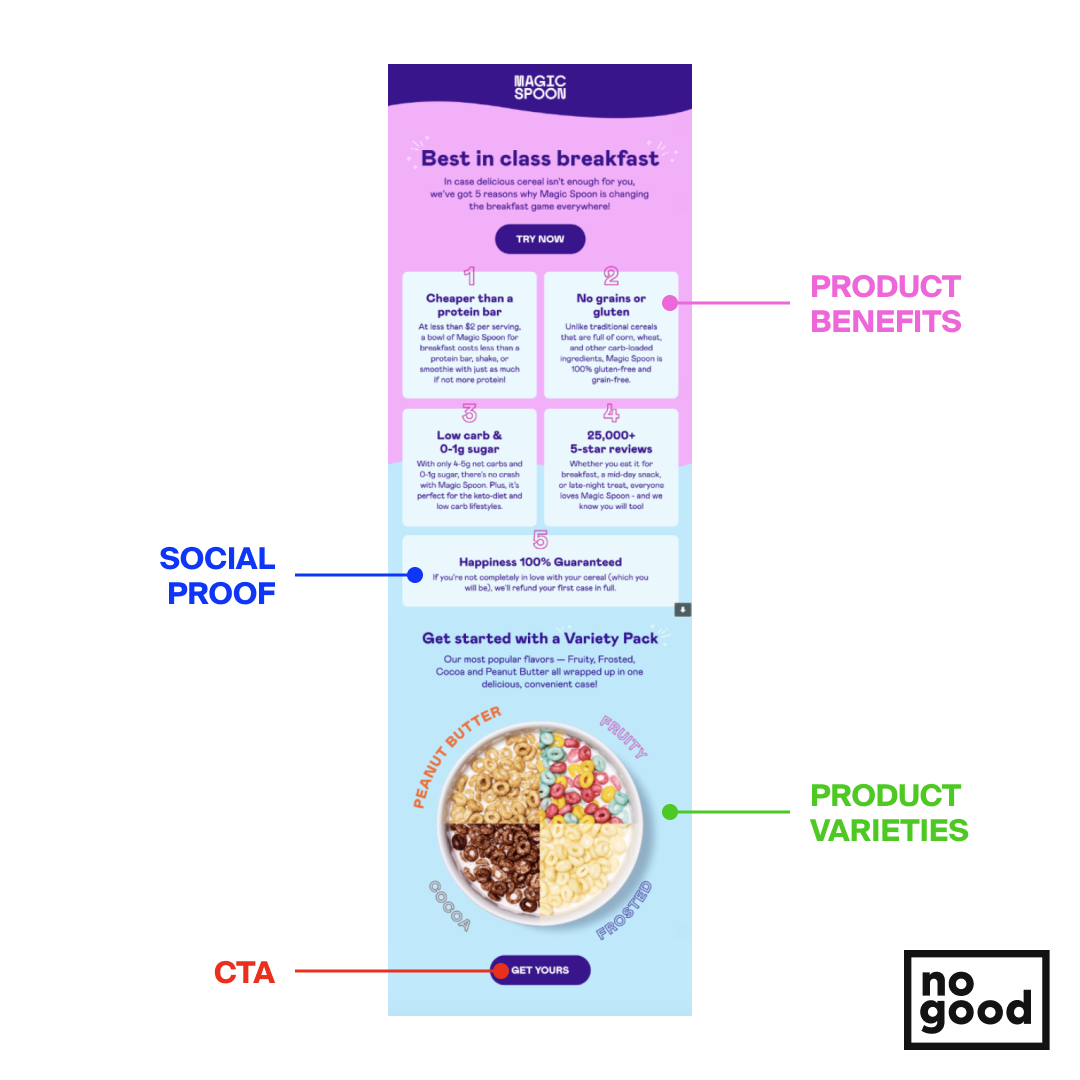
SMS / Push Notification Copy
In contrast to emails, copywriting for SMS and push notifications has extremely limited real estate that needs to be optimized for maximum impact. Because of the space and character limit, headlines need to be catchy, messaging needs to be (extremely) concise, and benefits need to be immediately obvious. A common way to increase engagement in shorter copy formats like SMS and Push is to use emojis to supplement your headlines (note: emojis count for 2 x characters).
Since SMS and Push notifications don’t include a specific CTA button like landing pages, ads and emails do, the CTA should be integrated into the message itself. For example, content platform Invisibly encourages the user to perform 3 actions: “take surveys, earn points, and access your favorite subscribers”, and demonstrates the value of doing so “without the subscriptions and ads”.
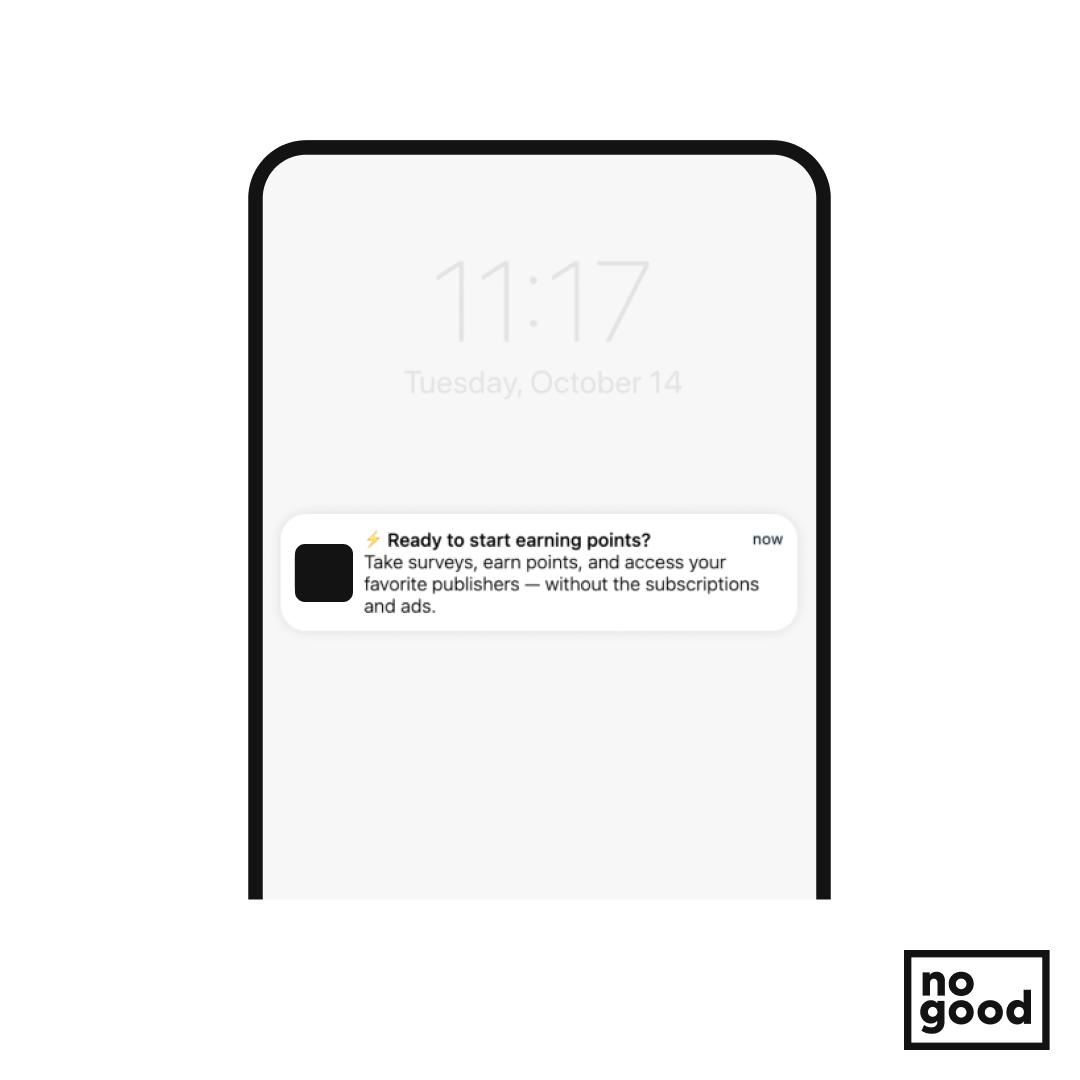
Knowing your brand voice
Your brand voice is one of the most important pieces of marketing copywriting. It’s the audience-facing, distinct personality that is consistent and evident across all communication touchpoints. This voice usually manifests across a brand’s website, social media posts, blog posts, ads, emails, etc. An easy way to envision this would be to imagine your brand as a person.
Are they playful and humorous or serious and knowledgeable? Are they your close friend, an expert mentor, or a helpful colleague? What phrases, vocabulary, and stylistic choices do they routinely use when talking to you? If the way a person talks is part of their personality, the way a brand communicates is likewise a part of their identity, positioning, and overall distinctiveness.
Normally, your brand’s voice is a key element of your brand’s guidelines. The brand voice guideline should specify the do’s and don’t’s to copywriting and the rationale behind why you chose specific characteristics that tie back to your brand identity. When writing marketing copy, it’s important to stick to these guidelines to maintain consistency across channels and touchpoints while still tailoring your message to specific audiences and platforms on a more micro level.
One common mistake is to see brand voice and tone as interchangeable terms — which they’re not. Remember: your voice always remains constant. A brand voice should be an overarching personality that is relatively consistent across the board, while brand tone can vary across different social media platforms, audiences and intentions. For instance, your holiday cheer email or social media marketing post will sound very different from ad copy that’s creating a sense of urgency around a limited-time sale.
Simply put: your voice is consistent, but your tone can change. A brand’s voice is more about who they are and what they stand for on a macro level, and tone is more about how they communicate it at each micro touchpoint.
Will AI replace copywriters?
Unless you’ve been living under a rock, you’re sure to have noticed the increasing importance of leveraging artificial intelligence (AI) in copywriting and content marketing. AI copywriting tools like Japser.ai, Copy.ai or Anyword, as well as generative AI chatbots like ChatGPT, have taken over the copywriting space in a way that drastically changes the nature of any marketing copywriting role.
A lot of copywriters are worried about the impact that AI will have on their jobs: “Will AI take my copywriting jobs?”, they’ll ask. The short answer is no, but that necessitates a certain level of adaptability and quick learning on the copywriter’s part. The best copywriters know how to work with AI tools, not against them. Copywriters need to seamlessly integrate AI tools into their writing workflows, and hone in on the skills that AIs inherently lack. The “human touch” becomes more important than ever, as writers will need to shift their focus to revising AI-generated content to ensure quality, brand consistency, and platform suitability.
In an age where AI tools are able to take care of the writing and creation portion of the job, human copywriters need to expand their skill set and see copywriting as one piece of an overarching marketing strategy in order to avoid becoming obsolete. The best copywriters don’t just create content, they know how to emotionally resonate with their target audience, they understand the narrative of a buyer’s journey, and they know to consider how each piece of content fits into a larger channel or audience strategy.
Conclusion
Copywriting for digital marketing is an incredibly important skill. At the end of the day, all of us have access to the same ad platforms and tools. One of the best ways to stand out is by having impeccable copywriting. Especially now, content is accessible in all ways, and content creators are finding new platforms to tell their stories and engage an audience. Clean and effective copywriting will help you break through the noise and stand out from your competitors.
Following the above suggestions can help you create great copy by understanding the channel that you are creating the copy for, and thinking about how the copy can interact effectively with other visuals in your ads. Combine storytelling with great copywriting, and you will create effective communication with your target audience and hence, a successful ad.
If your copy can achieve these few important things, you’re well on your way to becoming a great marketing copywriter! If you’re looking for an agency to take the hard work off your plate – feel free to reach out to our team for a chat.





